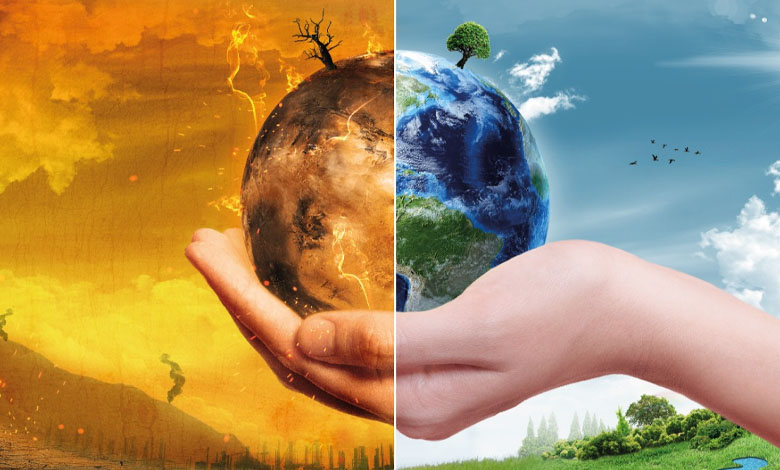UAE among world leaders in climate conservation initiatives

Climate change is represented by long-term shifts in temperature and weather patterns, which can be natural and occur, for example, through changes in the solar cycle. However, since the nineteenth century, human activities have become the main cause of climate change, mainly due to the burning of fossil fuels, such as coal, oil and gas.
This results in emissions of greenhouse gases, such as carbon dioxide and methane, which act like a blanket around the globe, trapping the sun’s heat and raising temperatures. It causes many changes and serious environmental disasters, such as hurricanes, floods, droughts and high temperatures, which negatively affect the population of the planet and cause human and economic losses, high poverty rates and other impacts, especially in poor countries.

Ever since they were aware of the catastrophic risks of climate change, the countries of the world have agreed on the imperative to confront this phenomenon and the need to reduce the emissions that cause it. Through more efforts to find practical solutions to the problem of global warming, which has become a source of concern for many countries and international organizations, these efforts have resulted in the conclusion of many international treaties and conventions.
Some countries have largely adopted best practices for preserving the planet and climate and have taken a leading role in preserving the environment.
Norway
Norway is among the countries that adopt best practices for climate conservation. Norway has the world’s largest electric car ownership and the government has pledged to eliminate emissions of polluting gases by 2030.
Portugal
One of the first countries to invest in the development of an integrated network of electric car chargers, which until recently were free. The Government provided incentives and facilities to citizens investing in renewable electricity generation and opened the doors for them to sell electricity generated from renewable sources to the electricity distribution network.
Uruguay
Uruguay adopts social and environmental policies that have qualified it to take the lead in South America in the index of countries that contribute to the preservation of planet Earth and climate. It has become a leading country in renewable energy electricity generation. In most major cities, most public transport is operated by electricity. Uruguay intends to operate the Carrasco International Airport in the capital, Montevideo, entirely by solar energy, making it the first airport in Latin America to have a solar power plant.
Kenya
The Kenyan Government has developed a plan to combat climate change, as part of its efforts to protect its agricultural activity, which is the most important resource of the economy after the increase of extreme weather and climate phenomena and the frequency of droughts and other repercussions of climate change that the country has suffered in recent years. The plan’s goals include reducing greenhouse gas emissions by 30% by 2030.
Kenyan authorities have also imposed a ban on the use of plastic bags to protect their waterways and the environment, with the ban described as the most drastic in the world. A person carrying a plastic bag (whether a tourist or a citizen) is subject to imprisonment or a heavy fine. Thanks to this plan and ban, Kenya was ranked 26th among the countries with best practices in planet and climate conservation.
New Zealand
New Zealand was ranked 39th globally and the first in the East Asia and Pacific region in the Positive Impact Index on Planet Earth and Climate. It is ranked among the highest in the world in terms of per capita carbon emissions. This is due to high CH4 emissions from the huge sheep and livestock grazing sector, as well as from the growing energy sector. This prompted the State to form a coalition of members of Parliament from different political parties, to eliminate harmful emissions completely by 2050.
Saudi Arabia
The Kingdom has unveiled the National Renewable Energy Program, through which it aspires to meet 50% of its domestic energy needs from renewable sources by 2030. It also launched the Saudi Green Initiative, a project to plant 10 billion trees in the country to mitigate carbon dioxide emissions.
The kingdom has been a leader in the “circular carbon economy,” an integrated strategy to address emissions while enabling economic growth endorsed by G20 leaders at the Saudi-led summit last year.
The Sakaka solar energy project was another sign of the kingdom’s aspirations for renewable energy sources, she said. Saudi Arabia is also leading the way in the use of hydrogen, which some in the energy field describe as the fuel of the future.
Morocco
Morocco is committed to implementing all its international commitments in mitigating climate change, adopting 60 measures that mainly include projects related to renewable energies and energy efficiency, which contribute up to 60 per cent of the total GHG emission reductions targeted.
Morocco attaches great importance to the fight against climate change and the protection of the environment, making it a regional leader in the field of renewable energies, because of its gigantic and ambitious project to produce solar energy in Ouarzazate.
United States of America
The US Department of Energy has announced a new international alliance, the Carbon Neutrality Forum for Producers, with Canada, Qatar, Saudi Arabia, and Norway to develop long-term strategies to achieve global carbon neutrality by 2050.
The United States announced its accession to Denmark, to co-lead an effort to decarbonize international shipping, with nearly 90% of world trade going by ship. President Joe Biden has also pledged to work with Congress to raise U.S. global climate funding to more than $11 billion a year – making the United States the single largest contributor to climate finance. It also achieved a 50-52% reduction in emissions in 2030 below 2005 levels, and then zero net emissions by 2050.
India
India has announced a new climate protection plan by 2030 while pledging to achieve carbon neutrality by 2070 and to increase tree cover to 235 million acres by 2030, as part of a commitment made in Paris in 2016.
UAE’s leadership in tackling climate change
Since joining the Vienna Convention for the Protection of the Ozone Layer and the Montreal Protocol in 1989, the United Arab Emirates has been able to set a global success story in its quest to develop the best ways to confront and limit the repercussions of the phenomenon of climate change, at a time when it is preparing to continue to impress the world by hosting Cup 28 next year, 2023.

It plans to diversify its energy mix and increase its share of renewable energy sources to 44% by mid-century under its National Energy Strategic Plan 2050.
The UAE’s initiatives to address climate change are as follows:
Strategic Initiative for Climate Neutrality 2050
The UAE is the first country in the Middle East and North Africa to announce a climate neutral target by 2050.
National initiatives
The launch of the UAE National Climate Change Plan 2017-2050, which provides a roadmap for supporting national activities and initiatives to address climate challenges
Emission control
The United Arab Emirates has initiated 14 projects to reduce greenhouse gas (GHGs) emissions under the umbrella of clean development mechanism projects.
Aquaculture technology
The Ministry of Climate Change and the Environment has begun to use soil-free aquaculture technology in various agricultural projects to combat the fundamental effects of climate change on natural ecosystems.
Natural gas combustion emissions
The United Arab Emirates is concerned with reducing emissions from the igniting of natural gas, such as the separation of waste gas or petroleum during testing or oil production.
Vienna convention for the protection of the ozone layer
The State participated in the Vienna Convention for the Protection of the Ozone Layer and the Montreal Protocol on Substances that Deplete the Ozone Layer in 1989. Since then, I have made great efforts to fulfill its obligations under the Convention and the Protocol.
Energy efficiency and effectiveness
The UAE has launched several innovative programs to increase energy efficiency and efficiency aimed at improving energy, smart transportation and entertainment
Source initiative
The Emirate of Abu Dhabi has allocated more than US$15 billion for renewable energy programs through the Masdar Initiative, which emphasized its dual commitments to the global environment and the diversification of the sources of the UAE economy.
Investment in renewable energy
The UAE is the first country in the Gulf to use a renewable energy strategy that includes nuclear energy, solar energy and natural gas that covers the majority of the country’s needs.
Sustainable means of transportation
The UAE is investing in new and sustainable mass transit systems such as the light and fast rail system (Dubai Metro) and the proposed high-speed train project.
Capture and storage of carbon dioxide
Capturing and storing carbon dioxide is one way to counter climate change by capturing carbon dioxide from large sources, such as power plants, and safely storing it underground, rather than emitting it in the atmosphere.












